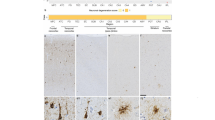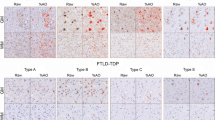Abstract
Frontotemporal dementia (FTD) is a prevalent neurodegenerative disease of heterogeneous histopathology. Neuropathological subtypes are identified on the basis of the presence or absence of tau- or ubiquitin-positive neuronal inclusions. Our recent work has established four disease stages that are independent of neuropathological subtype and reflect the clinical and degenerative progression observed in FTD. The variability in the extent of neuronal loss, astrogliosis, and microvacuolation are, therefore, more likely to reflect disease stage with potentially predictable differences between cases at early versus late disease stages. Understanding the variability in these parameters may assist in determining the importance of diverse disease subtypes in FTD. We examined 21 cases of sporadic, behavioural variant FTD and quantified the progression of histopathological change. The neuropathology of early disease was marked by severe astrogliosis of both the frontal and temporal cortices and neuronal loss, which was more evident in upper cortical layers of the frontal lobe. In late disease, neuronal loss was evident from both layer III and V in frontal and temporal cortices, and particularly the CA1 sector of the hippocampus. In addition, we compared the neuropathology of Pick’s disease, dementia lacking distinctive histopathology and FTD with motor neuron disease, and found no difference in these pathological subtypes on the basis of neuronal loss, astrogliosis or microvacuolation. These results show that the earliest cellular changes in FTD occur in glia, and that disease stage rather than FTD subtype determines the pattern and extent of neuronal degeneration.



Similar content being viewed by others
References
Armstrong RA, Cairns NJ, Lantos PL (1999) Quantification of pathological lesions in the frontal and temporal lobe of ten patients diagnosed with Pick’s disease. Acta Neuropathol 97:456–462
Arnold SE, Han L-Y, Clark CM, Grossman M, Trojanowski JQ (2000) Quantitative neurohistological features of frontotemporal degeneration. Neurobiol Aging 21:913–919
Broe M, Hodges JR, Schofield E, Shepherd CE, Kril JJ, Halliday GM (2003) Staging disease severity in pathologically confirmed cases of frontotemporal dementia. Neurology 60:1005–1011
Brun A, Englund B, Gustafson L, Passant U, Mann DMA, Neary D, Snowden JS (1994) Clinical and neuropathological criteria for frontotemporal dementia. J Neurol Neurosurg Psychiatry 57:416–418
Constantinidis J, Richard J, Tissot R (1974) Pick’s disease. Histological and clinical correlations. Eur Neurol 11:208–217
Dickson D (1998) Pick’s disease : a modern approach. Brain Pathol 8:339–354
Dickson DW (2001) Neuropathology of Pick’s disease. Neurology 56:s16–s20
Dickson DW, Yen S-H, Suzuki KI, Davies P, Garcia JH, Hirano A (1986) Ballooned neurons in selected neurodegenerative diseases contain phosphorylated neurofilament epitopes. Acta Neuropathol 71:216–223
Eng LF, Ghirnikar RS (1994) GFAP and astrogliosis. Brain Pathol 4:229–237
Hauw JJ, Duyckaerts C, Seilhean D, Camilleri S, Sazdovitch V, Rancurel G (1996) The neuropathologic diagnostic criteria of frontal lobe dementia revisited. A study of ten consecutive cases. J Neural Transm 47 [Suppl]:47–49
Heyman A, Wilkinson WE, Hurwitz BJ, Helms MJ, Haynes CS, Utley CM, Gwyther LP (1987) Early-onset Alzheimer’s disease. Neurology 37:980–984
Hodges JR, Miller B (2001) The classification, genetics and neuropathology of frontotemporal dementia. Introduction to the special topics papers: Part I. Neurocase 7:31–35
Hodges JR, Davies R, Xuereb J, Kril J, Halliday G (2003) Survival in frontotemporal dementia. Neurology 61:349–354
Hodges JR, Davies RR, Xuereb JH, Casey B, Broe M, Bak TH, Kril JJ, Halliday GM (2004) Clinicopathological correlates in frontotemporal dementia. Ann Neurol (in press)
Hutton M (1998) Association of missense and 5’-splice-site mutation in tau with inherited dementia FTDP-17. Nature 393:702–705
Jackson M, Lowe J (1996) The new neuropathology of degenerative frontotemporal dementias. Acta Neuropathol 91:127–134
Knopman DS, Mastri AR, Frey WH, Sung JH, Rustan T (1990) Dementia lacking distinctive histologic features: a common non-Alzheimer degenerative dementia. Neurology 40:251–256
Kril JJ, Halliday GM (2004) Clinicopathological staging of FTD severity: correlation with regional atrophy. Dement Geriatr Cogn Disord 17:311–315
Kril JJ, Patel S, Harding AJ, Halliday GM (2002) Neuron loss from the hippocampus of Alzheimer’s disease exceeds extracellular neurofibrillary tangle formation. Acta Neuropathol 103:370–376
Mann D (1998) Dementia of frontal type and dementias with subcortical gliosis. Brain Pathol 8:325–338
Mann DMA, South PW, Snowden JS, Neary D (1993) Dementia of frontal lobe type: neuropathology and immunohistochemistry. J Neurol Neurosurg Psychiatry 56:605–614
Martin JA, Craft DK, Su JH, Kim RC, Cotman CW (2001) Astrocytes degenerate in frontotemporal dementia: possible relation to hypoperfusion. Neurobiol Aging 22:195–207
McKhann GM, Albert MS, Grossman M, Miller B, Dickson D, Trojanowski JQ (2001) Clinical and pathological diagnosis of frontotemporal dementia. Arch Neurol 58:1803–1809
Nakamura Y, Takeda M, Yoshimi K, Hattori H, Hariguchi S, Hashimoto S, Nishimura T (1994) Involvement of clathrin light chains in the pathology of Pick’s disease: implications for impairment of axonal transport. Neurosci Lett 180:25–28
Norton WT, Aquino DA, Hozumi I, Chiu FC, Brosnan CF (1992) Quantitative aspects of reactive gliosis: a review. Neurochem Res 17:877–885
Ratnavalli E, Brayne C, Dawson K, Hodges J (2002) The prevalence of frontotemporal dementia. Neurology 58:1615–1621
Schofield E, Kersaitis C, Shepherd CE, Kril JJ, Halliday GM (2003) Severity of gliosis in Pick’s disease and frontotemporal lobar degeneration: tau-positive glia differentiate these disorders. Brain 126:827–840
Su JH, Nichol KE, Sitch T, Sheu P, Chubb C, Miller BL, Tomaselli KJ, Kim RC, Cotman CW (2000) DNA damage and activated caspase-3 expression in neurons and astrocytes: evidence for apoptosis in frontotemporal dementia. Exp Neurol 163:9–19
Tolnay M, Probst A (2001) Frontotemporal lobar degeneration. Gerontology 47:1–8
Acknowledgements
We thank the donors for their valuable contribution to this study, Heather McCann and Melissa Broe for their assistance with tissue preparation, and clinical colleagues for the clinical case assessments. This work was supported by NH&MRC grant no. 301964.
Author information
Authors and Affiliations
Corresponding author
Rights and permissions
About this article
Cite this article
Kersaitis, C., Halliday, G.M. & Kril, J.J. Regional and cellular pathology in frontotemporal dementia: relationship to stage of disease in cases with and without Pick bodies. Acta Neuropathol 108, 515–523 (2004). https://doi.org/10.1007/s00401-004-0917-0
Received:
Revised:
Accepted:
Published:
Issue Date:
DOI: https://doi.org/10.1007/s00401-004-0917-0




